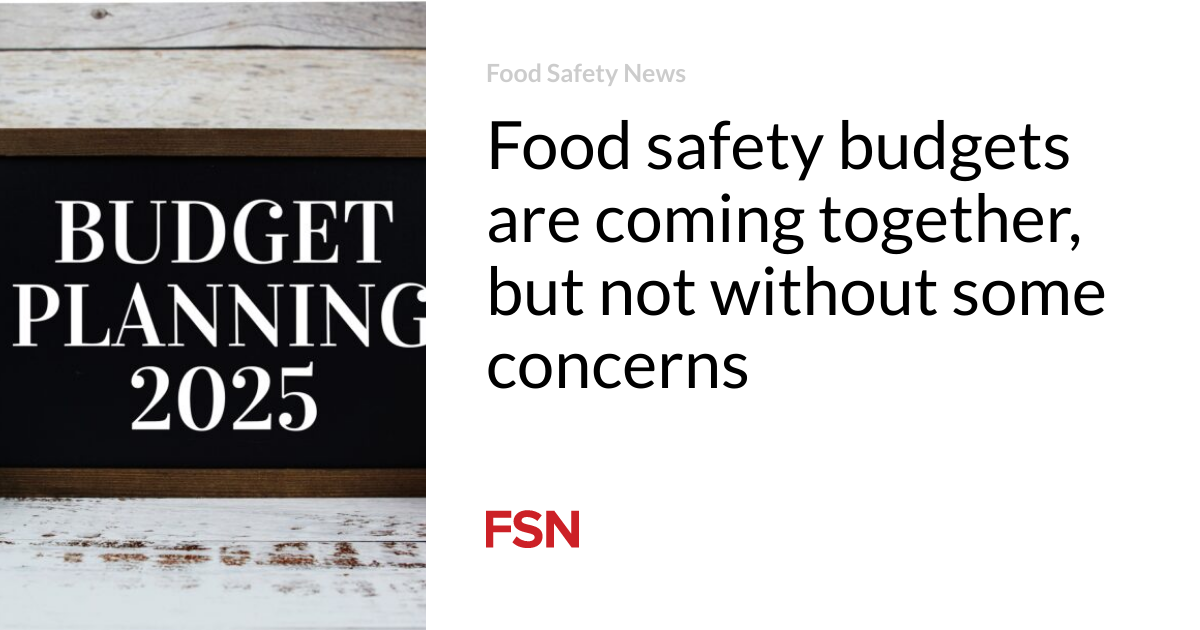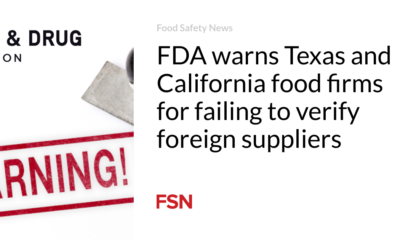Food
Food safety budgets are getting closer, but not without concerns

The USDA will have to live on about 1 percent less next year than this year, but the 2025 budget for the department’s Food Safety and Inspection Service will be $1.24 billion, an increase of $33.8 million from this year.
The USDA’s total budget for 2025 will be more than $22 billion, according to the 126-page recommendations made by a powerful subcommittee to the full House Appropriations Committee.
Meanwhile, the Senate Appropriations Committee approved its version of the FY 25 Agriculture/FDA funding bill on July 11. It provides a total of $6.87 billion in funding for the FDA, including $3.544 billion in discretionary funding – an increase of $22 million over fiscal year 2024, including an additional $15 million for food safety.
Senate Appropriations Committee Chairman Murray (D-WA) did not announce a minimum schedule for consideration of the farm/FDA funding bill. However, she did say she expects the committee to hold additional markup sessions on the remaining appropriations bills when the Senate reconvenes in two weeks.
The House Appropriations Committee approved the FY 25 Agriculture/FDA Appropriations Subcommittee bill on a party-line vote of 29-25, which is $182 million less than the President’s request.
The last of 12 appropriations bills in the House of Representatives provides $3.5 billion for the FDA salaries and expenses bill. This is $22 million below FY24 levels. This reduction means the agency will have to absorb mandatory wage increases. The bill also does not provide funding for Buildings and Facilities.
Committee Chairman Tom Cole (R-OK) said, “The bill also provides an appropriate level of funding for the Food and Drug Administration, ensuring it can fulfill its primary mission: to protect and promote the safety of America’s food, pharmaceutical and medical sector. devices.”
Subcommittee Member Sanford Bishop said, “We must ensure that the USDA, FDA, CFTC and other agencies have the resources necessary to continue to provide America with the highest quality, safest, most abundant and most affordable food and fiber products. , medicines and medical devices anywhere in the world.”
No changes were offered that would affect FDA funding levels. Instead, the references to the FDA focused on provisions in the bill regarding limitations on FDA regulatory authorities.
The House of Representatives is on recess this week for the Republican National Convention. It is then scheduled for hearings on July 22 and 29. The plan is to complete full House consideration of the seven remaining appropriations bills, including Agriculture/FDA, before the extended recess begins on August 2.
The Ag/FDA spending bill passed by the House Appropriations Committee was disappointing. It will provide the FDA with approximately $20 million less in taxpayer dollars in FY25 than is available to the FDA in the current fiscal year. In practice, the decline is much larger because the reduced level of FY25 funding will nevertheless need to fund new initiatives, program growth, mandatory salary increases, and building and facility repairs. The net loss for the Agency is at least $150 million compared to FY24 final appropriations.
The Ag/FDA funding bill passed by the Senate Committee is an improvement, but still leaves the agency with significantly less money than it will need in FY25. It includes a small increase of $22 million to taxpayers. However, the Agency will still have to pay well above that amount for new initiatives, program growth and mandatory salary increases. The net loss for the agency is at least $100 million compared to the final FY24 appropriations.
The Alliance for a Stronger FDA and Steven Grossman, its executive director, were the most helpful sources for this report. Grossman is now concerned about the budget levels looming in both the House of Representatives and the Senate.
“The FDA continues to enjoy bipartisan support in Congress, as evidenced by supporting statements from members the importance of the agency,” Grossman said. “Additionally, there is an uncertain potential that a higher spending limit in the Senate could ease spending constraints. We will continue to pressure Congress to recognize and fund the FDA’s critical work. We also welcome any development that could increase overall federal spending and translate into tangible support for the FDA’s growing mission and responsibilities.”
Back to the current one, he says The FY24 funding cycle is useful.
“As part of the President’s FY 24 budget request, the Administration has called for an increase in FDA’s BA (non-user fee) appropriations by $370 million. This wasn’t just the FDA’s opinion. The request should have been signed by HHS and OMB; they agreed that the FDA’s responsibilities were growing rapidly and needed much more support,” says Grossman.
“In response, Congress kept FDA funding for FY24 at approximately the same level ($3.5 billion) from FY23 to FY24. To be more precise, the final amount decreased by $8 million,” he continued.
“Of course the net impact was much worse than the stated amount. For slightly less money than in the previous fiscal year, the FDA had to absorb the costs of mandatory wage increases ($105 million) and find $50 million in existing program funding to reallocate to initiatives specified by Congress. In addition, other new initiatives in FY24 or predictable program growth were not taken into account.”
Grossman says one of the Alliance’s biggest fears is the potential for a second year of “flat funding” that masks a significant decline in agency support. If that were to happen, the FDA’s purchasing power could decline by as much as 10 percent within 18 months.
(Click here to sign up for a free subscription to Food Safety News.)













